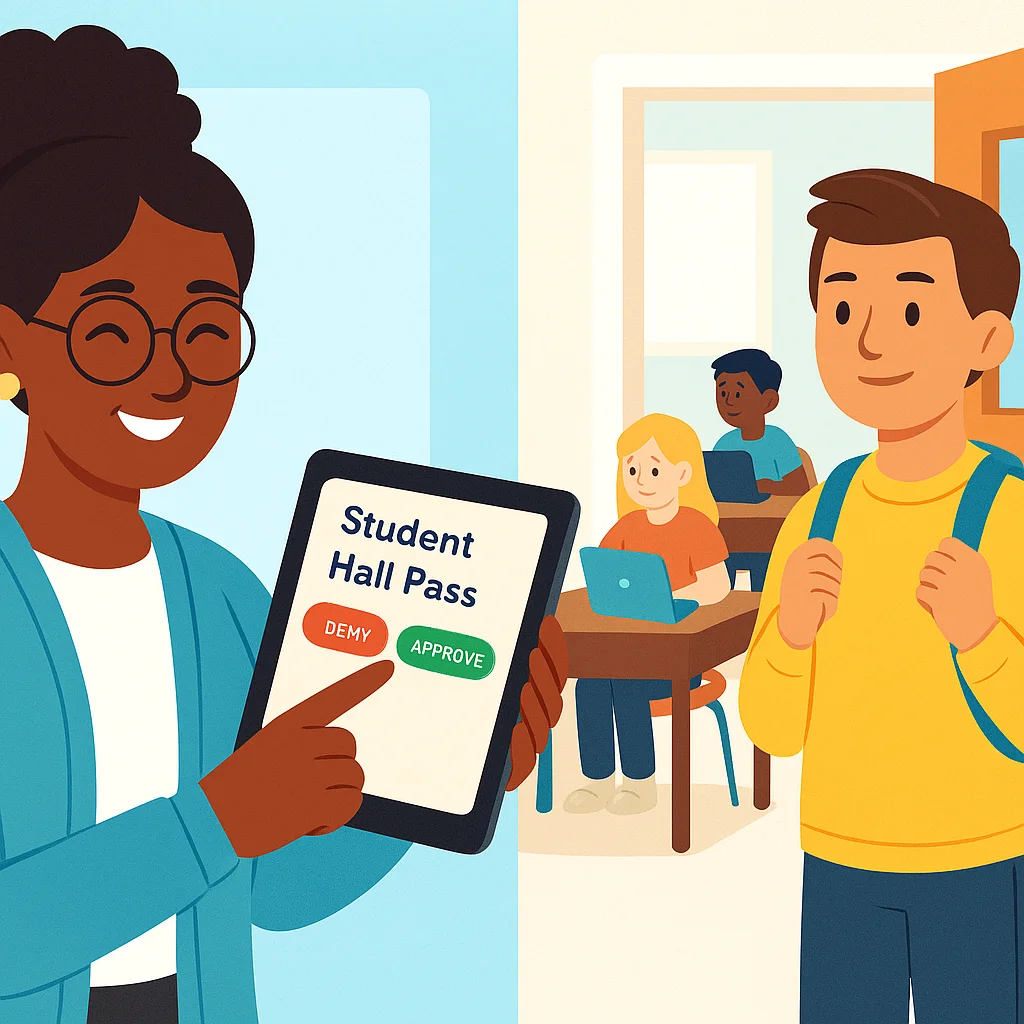General
eHallPass: The Complete Guide to the Digital Hall Pass System

Introduction
Managing student movement has always been one of the trickiest parts of school administration. Traditionally, schools relied on paper-based hall passes. Students would carry slips of paper, wooden boards, or teacher-signed notes whenever they needed to leave the classroom whether for the restroom, the nurse’s office, or the library. While this method worked for decades, it came with major drawbacks: lost passes, lack of accountability, classroom disruption, and no real data for administrators.
This is where eHallPass comes in. It is a cloud-based digital hall pass system designed to replace outdated paper passes with a smart, secure, and trackable solution. By digitizing the hall pass process, eHallPass creates more transparency, enhances school safety, and ensures accountability for students.
What is eHallPass?
eHallPass is a web and mobile-based application that allows teachers to issue digital passes to students who need to leave class. Instead of relying on paper, the process becomes secure, contactless, and fully trackable.
For example:
- A student requests permission to go to the restroom.
- The teacher receives the request on their dashboard and approves it with one click.
- The system automatically logs the time, purpose, and duration of the pass.
- If the student stays out too long, alerts are sent to staff.
In short, eHallPass transforms a simple hall pass into a complete system for student accountability and school-wide safety.
Key Features of eHallPass
-
Digital Pass Creation
- Students create a request through their device or the classroom computer.
- Teachers approve or deny the request instantly.
- Every pass is automatically stored and time-stamped in the system.
-
Real-Time Monitoring
- Teachers and administrators can see exactly how many students are out of class at any given time.
- Alerts notify staff if students exceed their time limits.
-
Analytics & Data Insights
- Detailed reporting shows:
- Which students request the most passes
- How long they typically stay out
- Which destinations (nurse, counselor, library, restroom) are used the most
- This data helps identify patterns in student behavior and can even highlight underlying issues.
- Detailed reporting shows:
-
Safety Tools
- The system supports “student-to-student restrictions.” For example, if two students are prone to misbehavior together, the system won’t allow both to leave at the same time.
- In emergencies, administrators can instantly locate students who are outside the classroom.
-
Contactless & Hygienic
- No exchange of papers or physical passes.
- Suitable for post-pandemic school environments where hygiene is a priority.
-
Customizable Settings
- Schools can set limits such as “maximum three restroom passes per day” or restrict pass usage during certain periods.
Benefits of eHallPass
1. Improved Classroom Management
Teachers no longer need to stop teaching, sign slips, or argue with students about excuses. Pass approval is quick, digital, and less disruptive.
2. Student Accountability
Because every movement is recorded, students know they are being tracked. This discourages unnecessary requests and misuse of passes.
3. Data-Driven Decisions
Administrators can use eHallPass reports to:
- Identify students who frequently visit the nurse (potential health concerns).
- Spot patterns of restroom overuse (possible avoidance of classwork).
- Understand when and where students are most likely to request passes.
This data goes beyond “who left the class” and actually helps schools improve policies.
4. Enhanced Safety and Security
From bullying prevention to emergency evacuations, eHallPass strengthens school safety. Staff always know where their students are, reducing risks and limiting unsafe student interactions.
5. Increased Efficiency
eHallPass saves schools thousands of sheets of paper, reduces teacher workload, and creates an automated tracking system—all leading to significant long-term cost and time savings.
Challenges of eHallPass
Like any digital system, eHallPass also presents some challenges:
- Technology Dependence: Reliable internet and devices are required for smooth functioning. Schools without infrastructure may struggle to implement it effectively.
- Student Resistance: Initially, students may feel restricted because their movements are being logged. However, with time, most adapt to the new system.
- Privacy Concerns: Since data is being stored, schools need to ensure compliance with privacy regulations and data protection.
- Training Requirements: Teachers and staff require onboarding to get used to the platform for maximum benefit.
How Does eHallPass Work in a School Setting?
Here’s a step-by-step example:
- Student Submission: The student logs into the system and submits a pass request (for restroom, nurse, library, etc.).
- Teacher Approval: The teacher quickly reviews and approves it on their eHallPass dashboard.
- Tracking: A timer begins, monitoring how long the student is outside.
- Alerts: If a student takes longer than allowed, the teacher and admin receive an alert.
- Reports: At the end of the day, the system generates data logs for administrators.
This makes the entire hall pass process transparent, trackable, and data-driven.
Why Should Schools Use eHallPass?
- For Safety – Schools can prevent unauthorized wandering, monitor interactions, and keep students accountable.
- For Teachers – Less paperwork, fewer disruptions, and improved classroom focus.
- For Students – A fair and consistent system that applies equally to everyone.
- For Administration – Access to powerful analytics and behavior insights that were never possible with paper passes.
Simply put, schools that care about accountability, efficiency, and safety should strongly consider adopting eHallPass.
Frequently Asked Questions (FAQs)
Q1: Is eHallPass only for restroom breaks?
➡️ No. It can be used for the nurse’s office, counselor visits, library trips, office tasks, and more.
Q2: Do students need personal smartphones to use eHallPass?
➡️ Not necessarily. Schools usually provide access via classroom computers, tablets, or Chromebooks.
Q3: Does eHallPass track student GPS location?
➡️ No. It only tracks pass requests, approvals, and time logs. It does not invade personal privacy by tracking movement outside classrooms.
Q4: Is eHallPass expensive for schools?
➡️ Costs vary depending on school size, but overall the system often saves money by eliminating paper passes and improving efficiency.
Q5: Can parents see their child’s eHallPass reports?
➡️ Some schools share summaries with parents, though it depends on the school’s policy.
Conclusion
Education is evolving, and so are the tools we use to manage schools. The eHallPass digital hall pass system is more than just a replacement for paper slips it’s an integrated solution that promotes fairness, transparency, and accountability in schools.
By digitizing the hall pass system, schools can save time, improve safety, and gain insights that were never possible before. Teachers benefit from reduced disruptions, administrators gain valuable data, and students learn to be more responsible with their time.
Home Page: Space Coast Daily UK
General
How to Protect Kids from Mobile Addiction – Expert Tips

In a world where smartphones are ubiquitous, helping children develop a healthy relationship with technology is more important than ever. This guide distills expert insights into practical, evidence-based strategies you can put into action today. You’ll find clear steps, realistic expectations, and actionable takeaways that respect kids’ needs while safeguarding their well-being.
Understanding the Problem: Why Mobile Addiction Happens
Mobile devices offer immediate gratification, social connection, and a sense of mastery. For children and teens, these rewards can create patterned use that resembles addictive behavior. Key drivers include:
- Constant notifications and the fear of missing out (FOMO)
- Easy access to games, videos, and social apps
- Social validation through likes, comments, and shares
- A lack of offline activities that feel equally rewarding
Experts emphasize the importance of balancing autonomy with guidance. Rather than simply restricting, it’s more effective to help kids understand their own patterns and develop healthier habits.
Setting a Practical Framework: Family Guidelines
Clear, collaborative rules lay the groundwork for healthier use. Consider the following framework:
1) Establish a Media Plan
- Create a family “digital wellness plan” that outlines rules for device use, screen time limits, and safe online practices.
- Involve kids in the co-creation process to foster buy-in and accountability.
- Revisit and adjust the plan as kids grow and technology evolves.
2) Define Screen Time Boundaries
- Set realistic daily or weekly limits that align with age and responsibilities (homework, chores, sleep).
- Use technology to enforce limits when possible (parental controls, app timers) while explaining the rationale.
3) Designate Tech-Free Zones and Times
- No devices at the dinner table, during family activities, or in bedrooms (especially overnight).
- Encourage a wind-down routine before bed that minimizes stimulating content.
4) Prioritize Quality Over Quantity
- Favor educational, creative, and collaborative apps over endless scrolling or hyper-competitive games.
- Promote apps that encourage movement, learning, or social responsibility.
5) Model the Behavior You Want to See
- Demonstrate balanced device use in your own habits.
- Show how you handle notifications, take breaks, and engage in offline activities.
Practical Strategies for Day-to-Day Prevention
Turning guidelines into everyday actions requires consistency and small, sustainable steps. Here are evidence-informed tactics:
A) Create Structured but Flexible Routines
- Build predictable daily blocks for school, chores, reading, and family time, with built-in device usage windows.
- Preserve flexibility for special events, device-free weekends, or family activities to keep it engaging rather than punitive.
B) Implement Gradual Weaning, Not Abrupt Bans
- If usage has spiraled, start with manageable reductions (e.g., 30 minutes less per day for a week) rather than an overnight ban.
- Offer appealing offline alternatives (board games, outdoor time, crafts) to fill the void.
C) Use Technology Thoughtfully
- Schedule downtime features, app limits, and pause settings during school days.
- Turn off non-essential notifications and group chats that contribute to constant checking.
- Keep kids’ devices out of reach during study time.
D) Teach Digital Literacy and Self-Regulation
- Discuss how to recognize problem behaviors: compulsive checking, irritability, anxiety when offline.
- Practice “pause-and-reflect” moments: when a device buzzes, count to 10 before replying.
- Role-play scenarios (peer pressure, unsafe content, cyberbullying) to build resilience.
E) Encourage Active and Social Offline Activities
- Prioritize sports, clubs, music, or arts to provide rewarding non-screen experiences.
- Schedule regular family activities and outings that require collaboration and presence.
F) Foster Healthy Sleep Hygiene
- Remove devices from bedrooms at bedtime; use alarm clocks instead.
- Keep screens out of the bedroom at least one hour before sleep to support sleep quality.
G) Co-Create a “Tech Toolbox” with Kids
- Compile a list of app-approved activities, screen-free hobbies, and quick offline games.
- Let kids rate apps for enjoyment, learning value, and impact on mood to build self-awareness.
Special Considerations by Age Group
Different ages come with unique developmental needs and risks. Tailor strategies accordingly.
Preschool to Early Elementary (3–8 years)
- Focus on co-viewing and co-using apps to model healthy behavior.
- Limit screen time according to pediatric guidance (contemporary recommendations vary; consult your pediatrician for personalized advice).
- Emphasize imaginative play and hands-on activities.
Middle Childhood (9–11 years)
- Introduce structured digital citizenship lessons (privacy, passwords, respectful communication).
- Establish consistent routines that balance schoolwork, screen time, and physical activity.
- Monitor for signs of dependence such as anxiety when devices are unavailable.
Adolescence (12–17 years)
- Foster open dialogues about online safety, sexting, and social pressures.
- Encourage autonomy with agreed-upon privacy boundaries and periodic tech-free time.
- Encourage critical thinking about content, algorithms, and online influence.
Tools and Techniques: What Works, What Doesn’t
Some approaches are more effective than others. Here’s a quick appraisal:
- Effective:
- Family media plan with clear rules
- Consistent routines and rituals
- Positive reinforcement for healthy habits
- Tech tools to support limits (app timers, bed scheduling)
- Offline alternatives that are genuinely appealing
- Less effective or risky:
- Rigid bans without context
- Shaming or punitive threats (they often backfire)
- Relying solely on self-regulation without guidance
- Overloading with notifications or screens during the day
Creating a Supportive Environment: School and Community Roles
Children don’t navigate tech use in isolation. Schools, caregivers, and communities all play a part.
- Schools can incorporate digital literacy curricula that cover healthy screen habits, online safety, and balanced use.
- Pediatricians can screen for technology-related distress during visits and provide guidance.
- Community programs can offer free or low-cost extracurricular activities to reduce reliance on screens for entertainment.
Measuring Progress: How to Know You’re on the Right Track
Track both behaviors and well-being, not just screen time metrics.
- Behavioral indicators: reduced compulsive checking, improved focus, better sleep, more interest in offline activities.
- Mood indicators: fewer irritability spikes, more consistent mood, less anxiety when offline.
- Engagement indicators: increased participation in family activities, hobbies, or sports.
Use these practical checks:
- Weekly devices-free evenings and note any changes in mood or family connection.
- A simple journal for kids to log what they did offline versus on screen and how it felt.
- Regular family check-ins to adjust plans as needed.
Common Challenges and How to Overcome Them
- Pushback from kids who rely on screens for social connection: Emphasize balanced use and provide meaningful offline alternatives, while keeping lines of communication open.
- Parental fatigue: Share responsibilities among caregivers and set consistent rules that everyone supports.
- Transitions between school-free and school days: Adjust limits gradually to maintain continuity and reduce stress.
Frequently Asked Questions (FAQs)
- What is the best age to start setting screen-time rules?
- Begin early and adapt rules as children grow. Start with simple boundaries and gradually introduce more complex digital responsibilities.
- How can I reduce my child’s smartphone dependency without causing rebellion?
- Use collaborative planning, explain the rationale, and offer appealing offline activities. Consistency and empathetic communication are key.
- Do device-free meals really make a difference?
- Yes. They improve family interaction, reduce distractions, and create opportunities for meaningful conversation.
- Are parental controls effective?
- They can help enforce limits, but should be part of a broader strategy that includes dialogue, routines, and healthy alternatives.
- How do I talk to my teen about online safety without sounding judgmental?
- Use non-accusatory language, focus on shared goals (privacy, safety), and invite their input on potential risks and solutions.
- What should I do if my child hides their screen time?
- Open a non-judgmental conversation, identify triggers, and adjust boundaries while reinforcing trust and safety.
- How can schools support healthy tech use?
- By teaching digital literacy, providing clear guidelines, and creating supportive environments that encourage balanced screen time.
Conclusion: Turning Insight into Action
Protecting kids from mobile addiction isn’t about policing every tap or erasing curiosity. It’s about guiding them to become intentional, reflective, and resilient users of technology. Start with a collaborative family plan, model balanced behavior, and equip children with the tools to manage their own digital lives. With consistent routines, meaningful offline alternatives, and supportive dialogue, you can help kids enjoy the benefits of mobile technology while minimizing its potential harms.
More Posts
General
Scam Alert: The “Bloomberg” Impersonation Scheme

This report details a sophisticated scam that impersonates a well-known financial news organization, Bloomberg, to trick individuals into placing fraudulent advertisements. The scam involves fake emails, a fabricated website, and a promise of significant payment that is never fulfilled.
1. Initial Contact and Deception
The scam begins with an unsolicited email from an individual claiming to be interested in guest posting opportunities on your website.
Sender Name: Lucas Nethon (or a similar generic name)
Initial Email Content:
Hello there,
I hope this message finds you well.
I recently visited your website and noticed that you offer guest post opportunities.
I am interested in submitting my articles for publication on your website.
Could you please provide me with information on the submission process?
I would also like to know the cost of publishing one article.
I look forward to hearing back from you.
Thank you for your time
Best regards.
This initial contact is designed to be non-suspicious, establishing a seemingly legitimate business inquiry.
2. The “Business Proposal” – The Core of the Scam
Following your response to the initial inquiry, the scammer sends a more detailed proposal, impersonating a representative from Bloomberg.
Key Elements of the Deceptive Proposal:
- Impersonated Entity: “BRAD STONE from BLOOMBERG (Bloomberg.com)”
- Fabricated Website: “bloombergsources.com” (Note: This is a crucial detail – it’s a fake domain, likely registered to mimic the real Bloomberg.com)
- Alleged Purpose: To share business ideas on a new website.
- The Offer: Banner placement on your website.
- Stated Terms:
- Banner Placement Duration: 4 months
- Payment: $2100 for the 4-month period
- Payment Timeline: Within 7 working days
- Removal Clause: You would remove the ad if they requested it.
Example Email Content (as provided):
Business Proposal for Banner Advertising
I'm talking to BRAD STONE from BLOOMBERG (Bloomberg.com)
We're launching a new website (bloombergsources.com) where we'll share business ideas. We'd like to add a banner to your website. If you're interested, you can contact us via this Gmail or my professional email (bradstone@bloombergsources.com)
You can also visit our new website (bloombergsources.com)
Terms of the Proposal
Banner Placement
Our banner will be live on your website for 4 months
Payment
We'll pay you $2100 for the 4-month period
Payment Terms
Payment will be made within 7 working days
Removal
If we need to remove the ad, you'll remove it.
Next Steps
If you're interested, please get in touch with us via email to discuss further
Thanks
3. The “Execution” and Request for Details
If you agree to the terms, the scammer proceeds to the next stage, providing specific instructions for placing their fake advertisement.
Key Information Provided:
- Link Anchor: “Bloomberg Sources”
- Paragraph for Sidebar: A block of text about “Bloomberg Sources” and a contact email address (
michael@bloombergsources.com). - Website Link:
Bloombergsources.com - Payment Details: PayPal ID (
michael@bloombergsources.com), Registered Address (3 Queen Victoria Street, London EC4N 4TQ UK), VAT Number.
Example Email Content (as provided):
Hi,
I have sent you the link anchor and paragraph, You have to add the paragraph to the sidebar of your website
Link
Bloombergsources.com
Anchor
Bloomberg Sources
You can choose any of the paragraphs and add them to the sidebar of your website.
----------------------------------------------------------------------------------------
Global customers rely Bloomberg Sources to deliver accurate, real-time business and market-moving information that helps them make critical financial decisions please contact: michael@bloombergsources.com
------------------------------------------------------------------------------------------
Global customers rely Bloomberg Sources to deliver accurate, real-time business and market-moving information that helps them make critical financial decisions please contact
------------------------------------------------------------------------------------------
Please add our company details and mention that this ad will be for four months.
PayPal ID: michael@bloombergsources.com
Registered Address: 3 Queen Victoria Street, London EC4N 4TQ UK
Vat Number: 718787092
I'm Waiting
Thanks
4. The Aftermath: No Payment, No Response
After you have followed their instructions and implemented the fake advertisement on your website, the scammer disappears. They stop responding to your communications, leaving you with the advertisement live and no payment received.
Your Experience:
- You placed the link and content as instructed.
- You informed the scammer that the advertisement was live.
- You have been waiting for over 7 days with no response from the scammer.
How to Identify and Avoid This Scam:
- Verify the Source: Always be skeptical of unsolicited offers, especially those involving large sums of money. Conduct thorough due diligence on the company and the individual contacting you.
- Check the Domain: Scammers often use domain names that are very similar to legitimate ones (e.g.,
bloombergsources.cominstead ofbloomberg.com). Check the actual domain carefully. - Official Contact Channels: Real companies like Bloomberg will typically use their official email domains (
@bloomberg.com) and will not solely rely on Gmail for business proposals. - Look for Official Websites: Visit the official Bloomberg website (Bloomberg.com) and search for their advertising or partnership information. You will likely not find any mention of
bloombergsources.comor a “Brad Stone” in this capacity.
- Check the Domain: Scammers often use domain names that are very similar to legitimate ones (e.g.,
- Be Wary of Large Upfront Payments: While legitimate advertisers may pay upfront, be cautious of offers that seem too good to be true or involve unusual payment methods (like requesting you to pay a portion for “verification”).
- Research the Address and VAT Number: While scammers can fake these, a quick search might reveal inconsistencies or indicate the address is associated with many other businesses, which can be a red flag.
- Trust Your Instincts: If something feels off, it probably is. It’s better to miss out on a potential deal than to fall victim to a scam.
Actionable Advice:
- Remove the Advertisement: Immediately remove the link and any content related to
bloombergsources.comfrom your website to prevent further association with fraudulent activity. - Report the Scammer: If possible, report the email addresses and fake website to your email provider and relevant authorities (e.g., law enforcement, cybersecurity agencies).
- Educate Others: Share your experience to help prevent others from falling victim to similar scams.
- Space Coast Daily Uk
General
Converting Inductance Units: Henry, Millihenry, Microhenry Explained
A basic concept in electrical engineering and electronics is that of inductance. It is defined by Examples.com as “a property of electrical circuits where a change in electric current generates an opposing electromotive force through a magnetic field.”
To reiterate, then, inductance occurs due to a changing current in a conductor (such as a coil or wire) inducing a magnetic field. This, in turn, induces a voltage opposing the current change, in accordance with Lenz’s Law. It is an effect that plays a critical role in such components as inductors, transformers, and motors.
What Are the Units for Measuring Inductance?
The base unit for inductance in the International System of Units (SI) – the modern form of the metric system – is the henry (H). It is named after the American physicist Joseph Henry (1797-1878), who discovered self-inductance in an electric circuit.
The henry represents the amount of inductance that will produce a voltage of one volt when the current is changing at a rate of one ampere per second. Or to put it a simpler way: it quantifies the effectiveness with which a coil opposes changes in electric current.
While the henry is the standard unit for measuring inductance, inductors in electronic circuits frequently have much smaller values. To measure these, the millihenry (mH) or microhenry (µH) is typically used.
How Are These Inductance Units Related To Each Other?
Making a note of or memorising these relationships between henries, millihenries, and microhenries will serve you well in situations when you need to carry out quick conversions but might not have a calculator or conversion tool to hand:
How To Convert Between the Units of Inductance
Here, then, is your “cut out and keep” rundown of what you need to do to convert from one unit of inductance to another, whatever the given practical application may be:
So, to give an example, if you needed to work out how much2 henries would be in millihenries, the relevant calculation would be 2 H x 1,000 = 2,000 mH.
Or if you were trying to determine what 500,000 microhenries would be when converted to henries, you would use the formula 500,000 µH / 1,000,000 = 0.5 H.
Couldn’t You Just Use a Calculator to Convert from One Inductance Unit to Another?
Such tools are certainly easy enough to find online. It is a straightforward process to convert between henry and millihenry with this calculator on the RS website; you simply need to enter the relevant input value, before clicking “Calculate”.
As we alluded to above, though, you might not always have access to a device or the Internet in order to use such online tools. In any case, getting to grips with the aforementioned manual calculations can help reinforce your awareness and understanding of how henries, millihenries, and microhenries relate to each other.
To summarise, then, both manual calculations and the use of online conversion tools can be useful and relevant, including for verifying the accuracy of results. Combining these approaches can therefore help optimise both the speed andprecision of your work whenever you find yourself needing to convert between these units of inductance.
-

 Fashion2 weeks ago
Fashion2 weeks agoUnlock Your Natural Radiance: 5 Proven Remedies for Glowing Skin at Home
-

 Tech1 week ago
Tech1 week agoBreaking Free from Airport SIM Card Chaos: Your Asia Travel Connectivity Revolution
-

 General2 weeks ago
General2 weeks agoHow to Protect Kids from Mobile Addiction – Expert Tips
-

 Business5 days ago
Business5 days agoInside London’s Ultra-Exclusive Membership Venues And What Sets Them Apart
-

 Travel11 hours ago
Travel11 hours agoThe Ultimate Expedition: The Deep-Dive Guide on How to Prepare To Visit Vuzillfotsps




